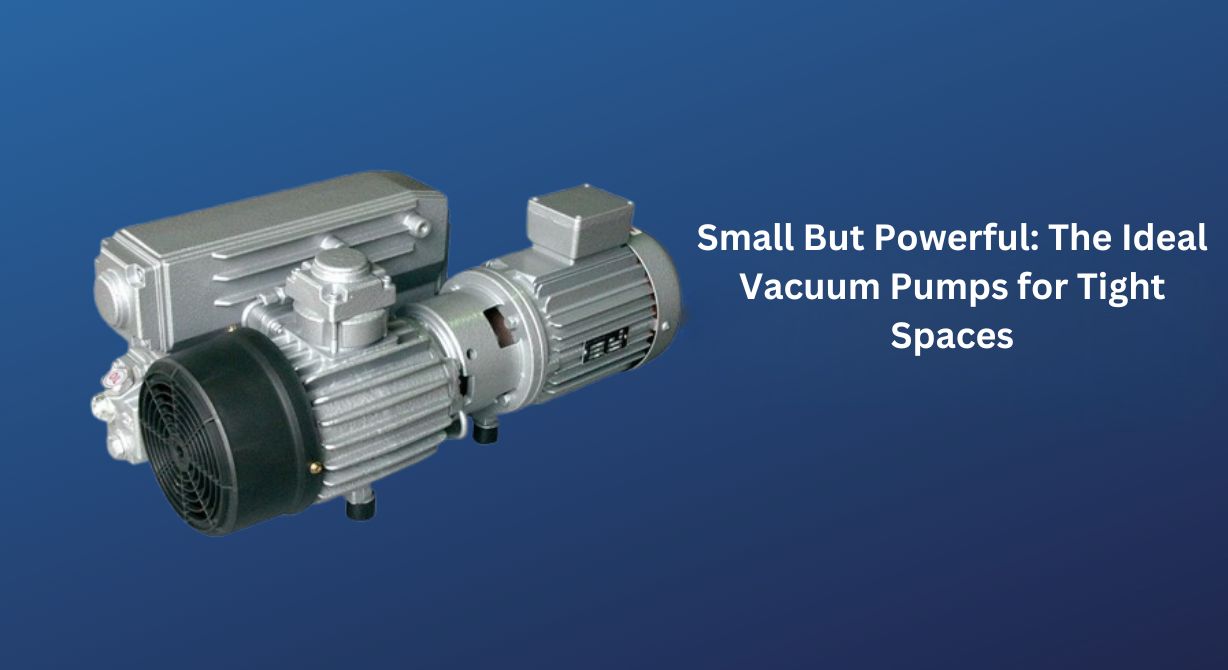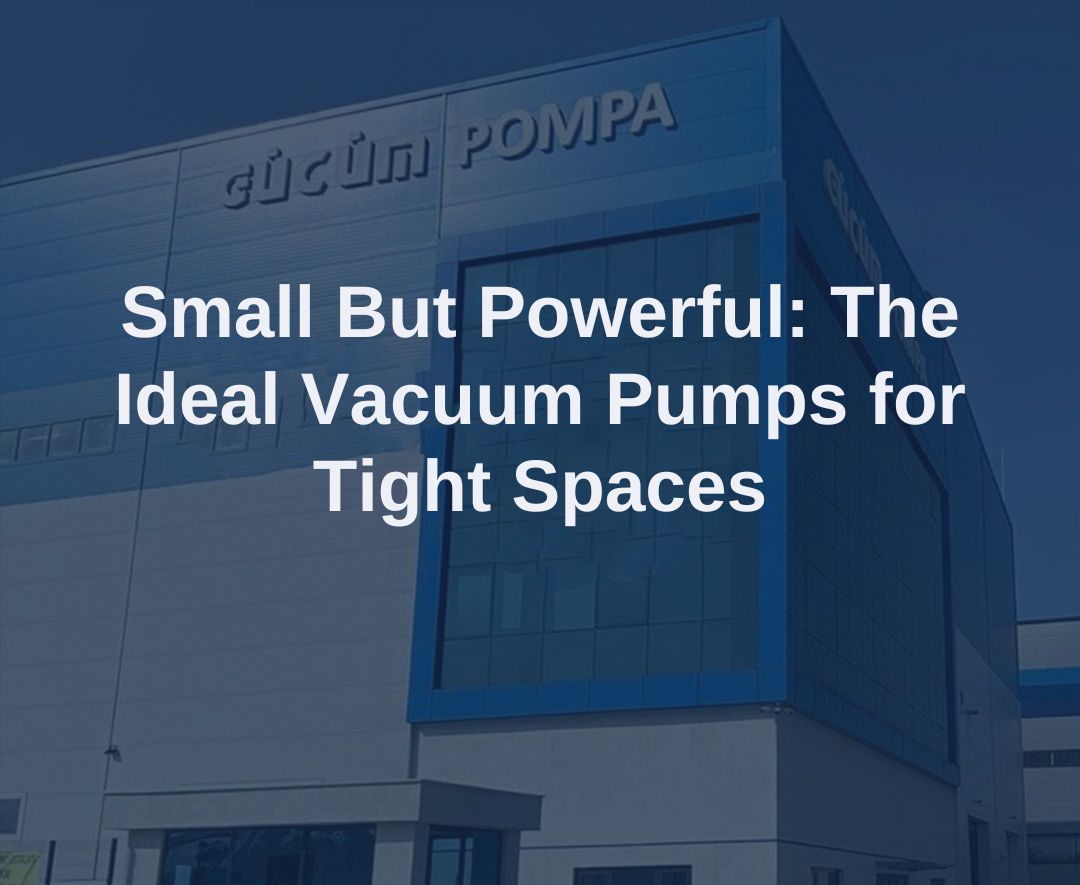Small But Powerful: The Ideal Vacuum Pumps for Tight Spaces
Table of Contents
- Maximum Performance in Tight Spaces: Which Are the Best Vacuum Pumps?
- Big Jobs with Small Vacuum Pumps: Selection Guide for Tight Spaces
- The Most Compact and Powerful Vacuum Pump Models for Confined Areas
- Don’t Let Vacuum Pump Size Restrict You: Solution Suggestions for Tight Spaces
- What to Consider When Choosing a Vacuum Pump for Tight Spaces?
- The Ideal Vacuum Pump: Compact Design or High Power?
Maximum Performance in Tight Spaces: Which Are the Best Vacuum Pumps?
Selecting vacuum pumps for industrial systems operating in tight spaces has always been challenging. Space limitations highlight not only the device size but also performance and energy efficiency criteria. Therefore, the best vacuum pumps stand out not only with their compact designs but also with high suction power and low friction values.
Firstly, low friction designs allow pumps to consume less energy and minimize heat generation. This contributes to the long lifespan of both the device and surrounding equipment in tight spaces. Additionally, quiet operation features increase comfort in enclosed areas and positively affect operator performance.
Another important criterion preferred in tight spaces is modular design and easy installation features. This enables the vacuum pump to fit easily into limited spaces and allows maintenance to be completed quickly. Also, IoT-supported models increase reliability with real-time monitoring and failure prevention systems, reducing maintenance costs.
The best vacuum pumps support sustainable production goals by balancing energy savings and high efficiency. Especially, compact-sized pumps save space in tight areas and create flexible application fields. Nowadays, magnetic bearing and oil-free vacuum pumps stand out in tight spaces with their low maintenance needs and high durability.
All these features form the fundamental criteria for selecting vacuum pumps that deliver maximum performance in tight spaces. Users should analyze their needs correctly and prefer vacuum pump solutions that overcome space constraints and reduce long-term operating costs.
Big Jobs with Small Vacuum Pumps: Selection Guide for Tight Spaces
Small vacuum pumps used in tight spaces are critically important in terms of high performance and efficiency. Space limitations require compact devices that maximize output without disrupting industrial processes. Therefore, when selecting a vacuum pump, not only size but also the pump’s durability, energy consumption, and maintenance ease should be considered.
Small pumps are especially preferred in sensitive applications such as laboratories, electronics manufacturing, and medical devices. In these fields, quiet operation also stands out. Because noise level in confined spaces directly affects operator comfort. At the same time, thanks to low friction technologies, these pumps produce less heat and have a longer lifespan.
Energy efficiency in small vacuum pumps reduces not only environmental impact but also operational costs. Thanks to IoT-supported models, real-time data tracking and remote control become possible. This optimizes maintenance processes and prevents unexpected failures. Additionally, compact design allows easy installation in small spaces, increasing flexibility in setup and operation.
In conclusion, to achieve big results with small vacuum pumps, the selection must consider not only size but also performance, reliability, and energy savings. Models balancing these aspects offer smooth and efficient operation in tight spaces.
The Most Compact and Powerful Vacuum Pump Models for Confined Areas
In industrial applications requiring work in confined spaces, compact vacuum pump models offer significant advantages. Despite their small size, these pumps provide high performance and are ideal solutions for maximizing efficiency in facilities with space constraints. When choosing vacuum pumps suitable for tight spaces, factors such as energy savings, power, and reliability must also be considered alongside size.
One prominent technology in these models is low friction designs, which reduce energy consumption and extend pump life. Additionally, some next-generation vacuum pumps offer IoT integration for real-time monitoring and control, optimizing maintenance processes and reducing failure risks. This provides both performance and operational ease in tight spaces.
Quiet operation features create a comfortable environment especially for employees working in enclosed and small spaces. Compact design also offers flexibility in installation; it fits easily into tight areas and lowers mounting costs. High efficiency and low energy consumption minimize operating costs and contribute to sustainable production.
Ultimately, when selecting vacuum pump models for confined spaces, criteria such as performance, durability, and energy efficiency should be prioritized. This way, space constraints are overcome while ensuring a highly efficient working environment.
Don’t Let Vacuum Pump Size Restrict You: Solution Suggestions for Tight Spaces
Using a vacuum pump in tight spaces often poses a significant challenge due to size limitations. However, with technological advances, compact and high-performance vacuum pumps now offer effective solutions even in confined areas. These pumps not only save space but also provide important advantages in energy efficiency and reliability.
Especially, modular designs and low friction components reduce pump sizes while increasing performance. Furthermore, smart sensors and IoT technology in some new models enable real-time monitoring of pump status, easing maintenance processes and preventing potential failures.
When choosing pumps for tight spaces, not only size but also quiet operation and long lifespan should be considered. Because in closed and cramped areas, both operator comfort and device durability are critical. At this point, high-tech vacuum pumps perform much better than traditional models.
In summary, vacuum pump size ceases to be an obstacle in tight spaces. With the right technology and design choices, space limitations can be overcome and high efficiency achieved.

What to Consider When Choosing a Vacuum Pump for Tight Spaces?
Choosing a vacuum pump for tight spaces must be done carefully due to space constraints and performance expectations. First, the pump’s dimensions and compact design are critical for efficient use of available space. Large pumps in confined areas cause installation difficulties and complicate maintenance processes.
When making a selection, energy efficiency and quiet operation features should also be considered. Noise level and energy consumption in closed and tight environments affect both working conditions and operating costs. Therefore, models with low energy consumption and quiet operation should be preferred.
Another important criterion is durability and maintenance ease. There may not be enough space for maintenance in tight areas, so long-lasting and low-maintenance pumps are more advantageous. Also, smart sensors and remote monitoring features reduce failure risks and ensure uninterrupted operation.
Regarding performance, the pump’s vacuum capacity and airflow rate should suit the intended use. Choosing high-performance pumps that don’t excessively strain the space is necessary for operational efficiency.
Finally, brand reliability and after-sales service quality should not be overlooked when selecting a pump. Technical support and fast service in tight spaces directly affect business continuity.
The Ideal Vacuum Pump: Compact Design or High Power?
Finding the balance between compact design and high power when choosing a vacuum pump is a critical decision for businesses. While compact vacuum pumps are preferred for use in tight spaces, more powerful models stand out in industrial applications requiring high performance.
Compact design offers advantages such as space savings, easy installation, and low weight. These features make working in limited spaces possible and provide portability. However, as size decreases, the pump’s vacuum capacity and airflow are often limited, which can be insufficient for applications needing high power.
On the other hand, vacuum pumps offering high power demonstrate superior performance in large-scale industrial processes. High vacuum levels and continuous operation capacity provide reliability even in harsh conditions. However, these models generally occupy more space and are difficult to transport.
When making a selection, it is necessary to analyze the usage area’s needs and environmental conditions correctly. If space is limited and portability is important, compact design pumps should be prioritized. However, if performance and power requirements are high, high power vacuum pumps should be preferred.
Ultimately, vacuum pump selection is shaped according to the business priorities. Finding a healthy balance between compactness and power increases efficiency and cost-effectiveness in the long term.


